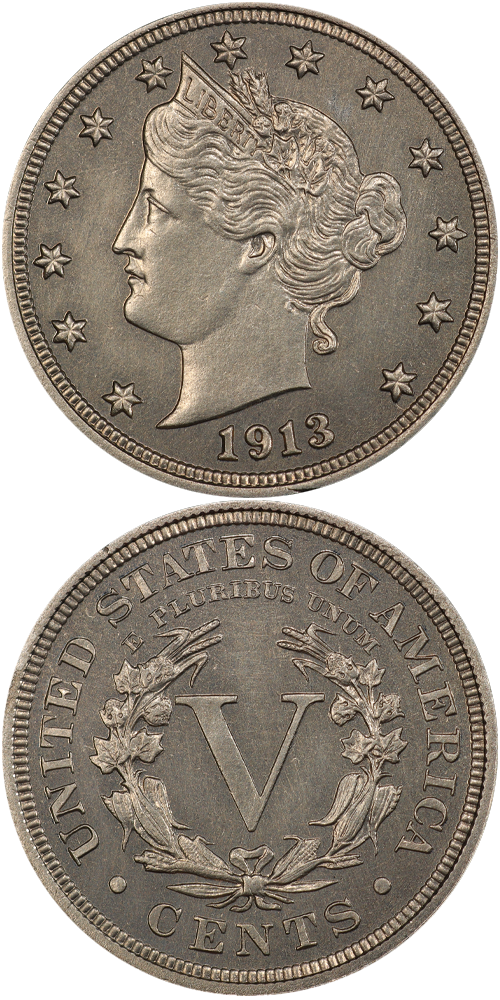1913 Liberty Head Nickel
Five examples are known to exist. Various stories have circulated concerning issuance of the 1913 nickels, but actual proof of the circumstances surrounding their leaving the Mint has never been documented. Theories include:
(1) They were struck to exchange for coins needed for the Mint Collection.
(2) A coiner at the Mint privately struck the pieces which years later found their way onto the numismatic market.
(3) They were struck exclusively for a wealthy collector.
Regardless of the "why" of issue, under standard Mint practices of the period all that was necessary for those who were responsible for their striking was to pay the Proof and Medal Fund eight cents for each coin and walk out of the Mint building with them.
It seems that the person involved was likely Samuel W. Brown, an established coin collector who lived in Philadelphia and worked at the Mint. Or, perhaps someone else was involved. In any event, when the nickels first became known to the collecting community, it was Brown who had them.
It was 1919 before the 1913 Liberty Head nickel first reached print. By that time Brown lived in North Tonawanda, New York, a town near Niagara Falls, where at a later time, he served as mayor. Either he already had all five Liberty Head nickels, or he had heard of them and wanted to acquire them, but whatever the reason, he advertised in the December 1919 issue of The Numismatist to pay $500 each for any such coins. In January 1920, he raised the ante to $600. Dave Bowers believes that the owner, at least in part, was Stephen K. Nagy, Philadelphia dealer and son-in-law of old-time professional numismatist John W. Haseltine. In his career Nagy handled many prime rarities, including all 10 of the known 1884 trade dollars and all five of the 1885 trade dollars. His style was always to work behind the scenes, to be in the background.
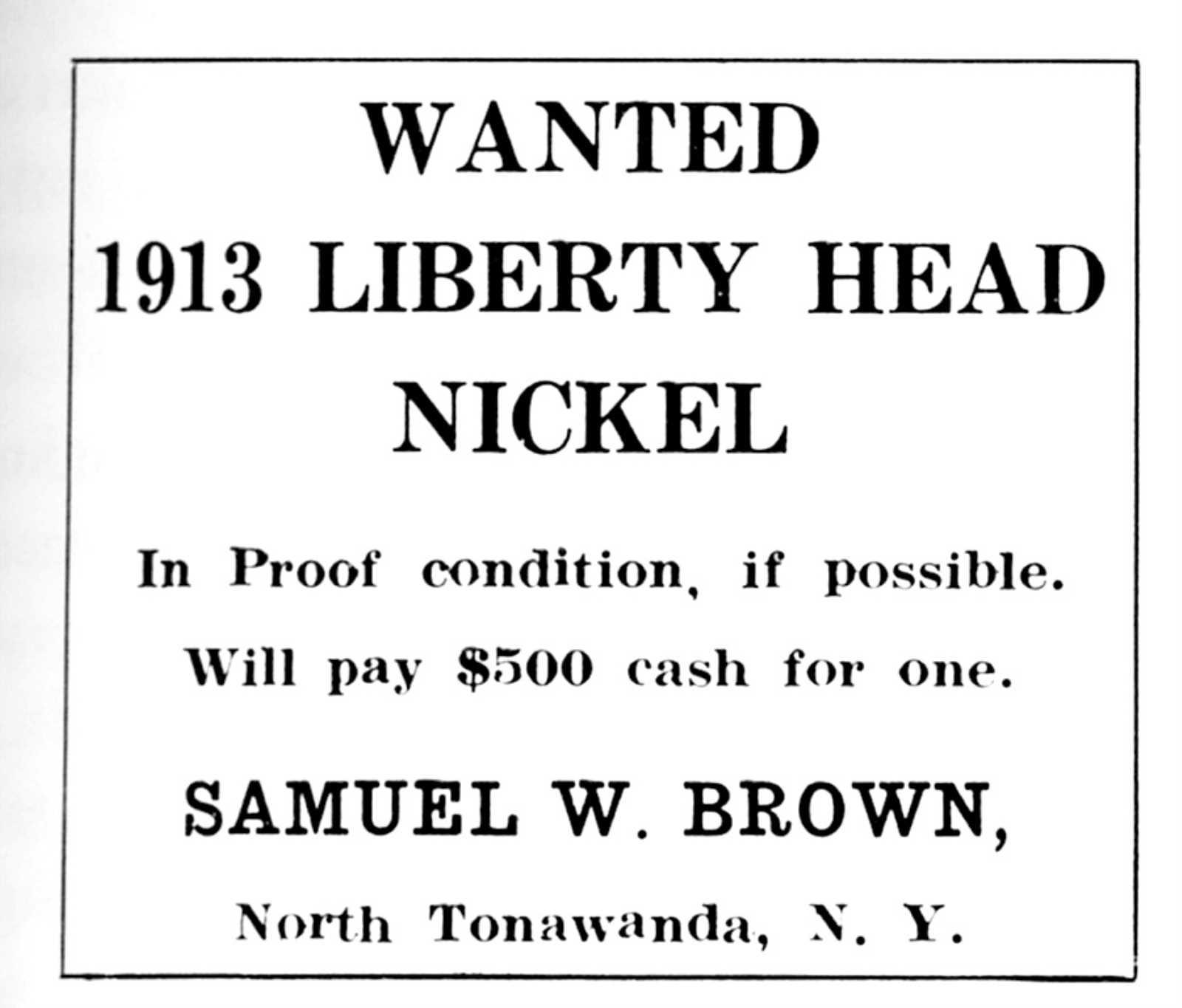 | 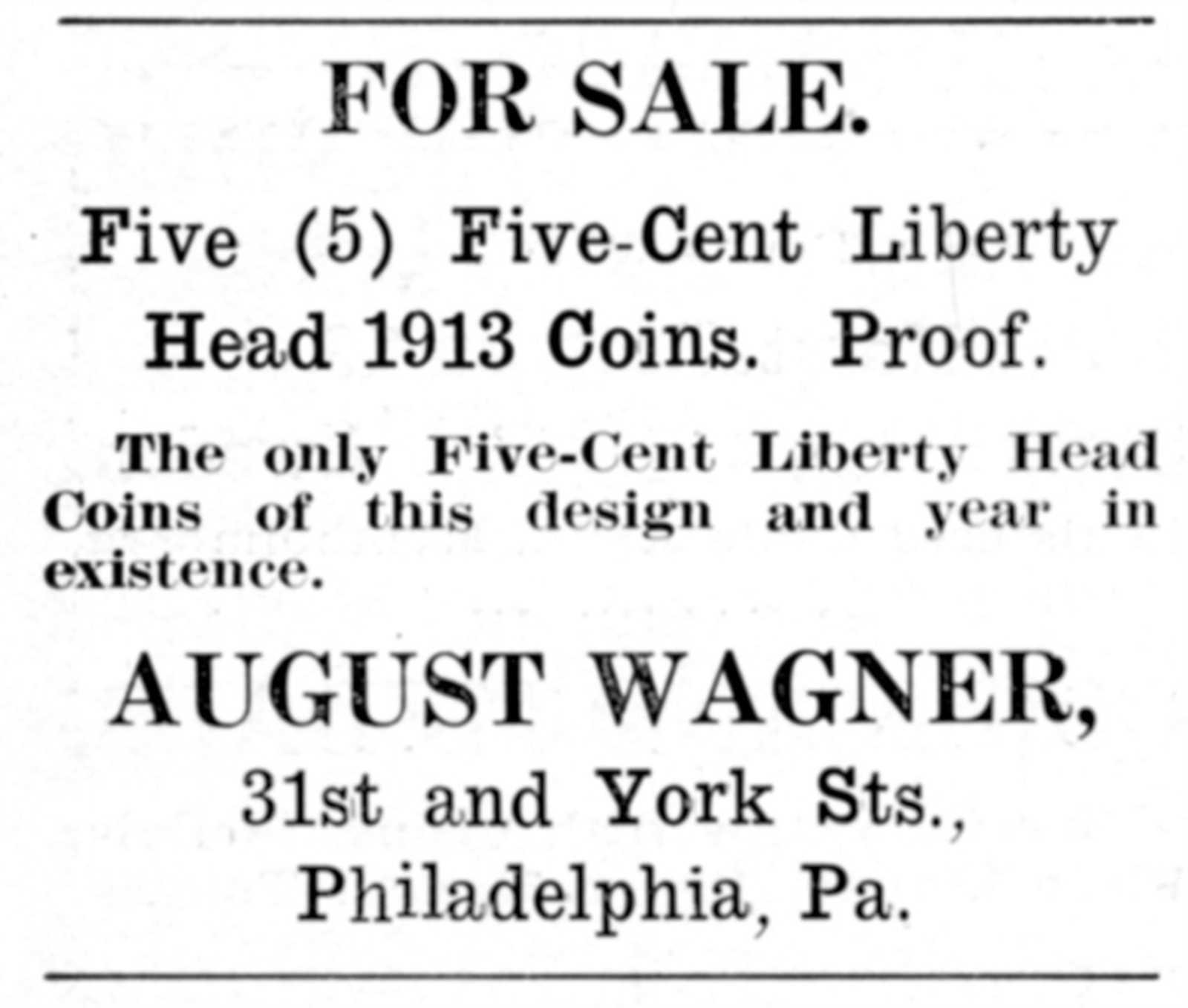 |
The Brown advertisements attracted wide notice. Various people in the Treasury Department, including at the Mint, received The Numismatist and no doubt saw the listings. Perhaps one of them had a group of 1913 nickels and came forth with an offer. Whatever the circumstances, in August 1920 Brown startled the collecting community by displaying five pieces, nicely fitted in a leather case. Not even the most experienced collectors and dealers had ever seen such pieces before.
In 1923 the nickels seem to have been consigned (rather than sold) to August Wagner, a Philadelphia dealer in stamps at 31st and York Streets, an ideal "front man." In The Numismatist, December 1923, Wagner advertised: "For Sale. Five (5)-Cent Liberty Head 1913 Coins. Proof. The only five-cent Liberty Head coins of this design and year in existence." Wagner did not find a buyer, and in 1924 Nagy sold them to New York City dealer Wayte Raymond, who placed them with Col. Edward H.R. Green.
Green was the eccentric son of millionairess Hetty Green, popularly known as the "Witch of Wall Street." After his mother passed away, Col. Green, as he became known, spent vast sums on his hobbies and interests. In time he could proudly point to such "collectibles" as a full-scale operating railroad in Texas, an antique whaling ship at harbor in Massachusetts, his own radio station, and vast collections of coins, stamps and paper money.
After Green's death in 1936 it took eight armored trucks to haul his valuables to safekeeping. His estate was handled by the Chase Bank, New York City. The appraisal of the numismatic portion of his estate was done by F.C.C. Boyd of New York City in 1938 and 1939, and a value of $1,240,299 was assigned.
As circumstances would have it, in St. Louis young Eric P. Newman, a numismatist and up-and-coming lawyer, desired to buy a piece of St. Louis currency from the Green estate, and wrote to inquire. For several years numismatists had been endeavoring to get hold of the treasures in the Green collection, but their approaches must not have been right, or the bank wasn't ready, or there may have been other reasons, for all were rebuffed. Eric P. Newman's inquiry concerning the Green estate arrived at the right time. Over a period of time several shipments of coins and paper money were quietly purchased from the Green estate by Newman and local friend, coin dealer Burdette G. Johnson.
Then the 1913 Liberty Head nickels became available. At first Newman made an offer for just the two coins that he thought were the finest. However, in time a deal was struck whereas $2,000 would be paid for all five examples. As Liberty Head nickels, dated 1913 or otherwise, were not among Newman's specialties, he dispersed them, one by one, with the finest quality piece being sold to Numismatic Gallery, who then sold it to Louis E. Eliasberg, Sr., of Baltimore in 1948. It thus became a showpiece in the greatest collection of United States coins ever formed -- a cabinet complete with every date and mintmark from the 1793 half cent to the 1933 double eagle.
The finest 1913 Liberty Head nickel would remain in the Eliasberg Collection for decades, with ownership eventually transferring to Louis' son Richard, after the former's death in 1976. In May 1996, the nickel crossed the auction block with other portions of the collection, at which time it set a world's record for the highest price ever paid (to that time) for a United States coin at auction, bringing $1,485,000. In the over two decades since this sale, this incredible rarity was treasured and cared for by multiple collectors before finally being acquired by Dr. William Morton-Smith, whose family has consigned it to the current sale.
After leaving the possession of Eric P. Newman, the other four 1913 Liberty Head nickels would wind their way through the hands of dealers and collectors that included kings and owners of department stores and professional sports teams. Two would eventually be donated to public institutions, one each to the National Coin Collection at the Smithsonian and to the American Numismatic Association Museum, leaving just three available to collectors.
Roster of 1913 Liberty Head Nickels
1 | The Norweb Specimen
The third of the 1913 Liberty Head nickels is the Norweb Collection specimen donated to the Smithsonian Institution, where it is a showpiece.
At one time it was a highlight in the fantastic collection of rare coins formed by His Majesty, King Farouk of Egypt. His reign began in 1936 and was notable for its incompetence, waste, and personal aggrandizement. Farouk was an avid buyer of numismatic rarities (and other collectibles) in the 1940s and at the time was the best customer of several American dealers. Numismatic Gallery sold sections of several major collections to Farouk, including patterns from F.C.C. Boyd and also a 1913 Liberty Head nickel.
On July 26, 1952, Farouk was overthrown by a military junta under Gamal Abdul Nasser and went into exile (where he continued to spend lavishly, but not on collectibles). The military government took over his possessions, and in 1953 announced they would be auctioned. The sale took place in Cairo in early 1954 under the direction of Sotheby's London office. A group of Americans decided to attend, including Abe Kosoff, Sol Kaplan, Ambassador and Mrs. R. Henry Norweb, Hans M.F. Schulman, John J. Pittman, James P. Randall, Robert Schermerhorn, Paul Wittlin, Gaston DiBello, and Maurice Storck, and members of some of their families. The 1913 Liberty Head nickel was included as part of a date collection of nickels, as Lot 1695, without any particular notice being made of it. Mrs. Norweb wanted to buy the 1913 and made this known to her fellow countrymen. The American contingent of bidders persuaded the auctioneer for Sotheby's, Mr. Levy, to extract it from the group and offer it separately, which was done, as Lot 1695A. The lot was won by Sol Kaplan, who transferred it to Abe Kosoff, from whom it went to Mrs. Norweb, who wished to buy the coin but did not want to attract attention.
In the 1970s the Norweb family, owner of the Farouk 1913 Liberty Head nickel, made several important gifts to numismatic institutions, including a 1787 Brasher doubloon and many other coins to the American Numismatic Society, New York. In 1977, to celebrate the year of their 50th wedding anniversary in 1978, Ambassador and Mrs. R. Henry Norweb decided to donate the 1913 Liberty Head nickel to the National Coin Collection at the Smithsonian Institution.
Among the four nickels, other than the Eliasberg Proof, this was once considered to be the second or third finest known by some observers. However, while in Farouk's possession it was dipped and lacquered. Today it probably ranks as third or fourth, far above the fifth.
• 1913-1920s, Samuel W. Brown and/or Stephen K. Nagy
• Early 1920s-1924, Stephen K. Nagy, likely on consignment for a time in 1923-1924 to August Wagner
• 1924, Wayte Raymond
• 1924-1936, Col. E.H.R. Green
• 1936-1941, Green Estate
• 1941-1942, Eric P. Newman
• 1942-1944, F.C.C. Boyd
• 1944, Numismatic Gallery
• 1944-1952, King Farouk
• 1952-1954, Government of Egypt
• 1954, Strategic partnership of Abe Kosoff and Sol Kaplan
• 1954-1978, Emery May Holden Norweb
• 1978-Present, Smithsonian Institution
• Million Dollar Nickels No. 1, there as the "Smithsonian Specimen."
—
2 | The Olsen Specimen
This particular coin went from Eric P. Newman and Burdette G. Johnson to coin dealer James F. Kelly. In 1944 it was offered in B. Max Mehl's catalog of the Fred Olsen sale, from which it was sold to King Farouk of Egypt, who found it to be redundant as he had acquired the Norweb coin (no. 3 above) and he did not wish to take possession of it. Over the next few years sales were attempted by various individuals but it was not until 1947, that Mehl was able to sell it by placing it in his catalog featuring the Will W. Neil Collection. The buyer was Edwin A. Hydeman, owner of Weist's Department Store in York, Pennsylvania, who would own it for a quarter of a century. The coin subsequently went to World-Wide Coin Investments, Ltd. and then on to other owners, including Dr. Jerry Buss, owner of a Los Angeles sports team. It would eventually find a home in the Reed Hawn Collection (auctioned by Stack's in 1993) and the Greensboro Collection.
• 1913-1920s, Samuel W. Brown and/or Stephen K. Nagy
• Early 1920s-1924, Stephen K. Nagy, likely on consignment for a time in 1923-1924 to August Wagner
• 1924, Wayte Raymond
• 1924-1936, Col. E.H.R. Green
• 1936-1941, Green Estate
• 1941-1942, Eric P. Newman
• 1942, Burdette G. Johnson
• 1942, James F. Kelly
• 1942-1944, Fred E. Olsen, collection auctioned by B. Max Mehl
• 1944-1947, King Farouk, most of this time in the possession of Mehl, to whom it was sent on consignment, finally to be sold in 1947 by listing it in the Will W. Neil Collection catalog
• 1947-1972, Edwin Hydeman
• 1972-1975, World-Wide Coin Investments
• 1974-1975, Bowers and Ruddy Galleries, Inc., jointly with World-Wide
• 1975, Possibly then to Continental Coin Co., with whom a transaction seems not to have been perfected
• 1975-1977, World-Wide Coin Investments
• 1977, Robert L. Hughes Enterprises, a subsidiary of A-Mark
• 1977, Superior Galleries
• 1977-1985, Dr. Jerry Buss, auctioned by Superior Galleries
• 1985-1993, Reed Hawn, auctioned by Stack's
• 1993-2002, Bought by Dwight Manley for Spectrum Numismatics and a Nevada investor
• 2002-2004, Laura Sperber, Legend Numismatics
• 2004, Donald W. Doyle, Jr., Blanchard & Co., Inc.
• 2004-2010, Midwest collection, auctioned by Heritage Auctions
• 2010-2014, Greensboro Collection, auctioned by Heritage Auctions
• 2014-2021, Unknown owner
• 2021-Present, Unknown owner via private transaction with Stack's Bowers Galleries
• Million Dollar Nickels No. 2, there as the "Hawn Specimen."
—
3 | The Eliasberg/Dr. Morton-Smith Specimen
This is the finest 1913 Liberty Head nickel, graded Proof-66 by PCGS and awarded CAC approval.
It seems to have been struck from Proof dies, but on an ordinary planchet. This example was selected by St. Louis numismatist and historian Eric P. Newman in 1942 as the one to keep from the group of five he purchased from the Col. Green estate. This and the Olsen coin, considered second finest, were the first two purchased by Newman, soon followed by the other three. Numismatic Gallery acquired this coin from Newman in 1948, and on December 14 of that year, Abe Kosoff, partner in the firm, offered it to Louis E. Eliasberg, Sr. The sale took place in early 1949.
This coin remained with Louis E. Eliasberg, Sr., then after his passing went to his son, Richard A., who in 1996 consigned it to Auctions by Bowers and Merena. It sold for $1,485,000, the first coin ever to cross the million-dollar barrier, a sensation. The buyer was Jay Parrino, who had made a splash by handling other rarities under his trade style, The Mint.
On July 29, 2003, a special reception was hosted by Steve Geppi and John Snyder of Diamond International Galleries, in their elegant facilities in Timonium, Maryland. This coin, by that time owned by Dwight Manley, had just been sold to Edward C. Lee, and this latest transaction was the subject of a special ceremony. Lee held it for nearly two years, then in June 2005 announced that title had been transferred to Legend Numismatics (co-owned by Laura Sperber), who earlier owned specimen no. 4. The coin went to Bruce Morelan and then to Ron Gillio. From Ron Gillio it was purchased by Dr. William Morton-Smith, who added it to his family's collection of rarities.
• 1913-1920s, Samuel W. Brown and/or Stephen K. Nagy
• Early 1920s-1924, Stephen K. Nagy, likely on consignment for a time in 1923-1924 to August Wagner
• 1924, Wayte Raymond
• 1924-1936, Col. E.H.R. Green
• 1936-1941, Green Estate
• 1941-1948, Eric P. Newman
• 1948-1949, Abe Kosoff and Abner Kreisberg trading as the Numismatic Gallery
• 1949-1976, Louis E. Eliasberg, Sr.
• 1976-1996, Eliasberg Estate to his son Richard A. Eliasberg
• May 1996, Bowers and Merena's sale of the Louis E. Eliasberg, Sr. Collection
• 1996-2001, Jay Parrino
• 2001-2003, Dwight Manley for the California Gold Marketing Group
• 2003-2005, Edward C. Lee
• 2005-2007, Bruce Morelan, Laura Sperber, and George Huang via Legend Numismatics
• 2007-2018, Dr. William Morton-Smith via Ron Gillio
• August 2018, Stack's Bowers Galleries ANA sale
• 2018-2021, Bruce Morelan
• 2021-Present, Private Collector via GreatCollections
• Million Dollar Nickels No. 3.
—
4 | The Walton Specimen
This and the McDermott coin (No. 5) are the only two pieces flatly struck at the ear of corn to the left of the ribbon bow on the reverse, perhaps indicating they were struck at a different time. This coin was deaccessioned by Eric P. Newman and was acquired by James F. Kelly, the Dayton jeweler and rare coin dealer. Kelly is thought to have sold it directly to Dr. Conway A. Bolt, Sr., although accounts are mixed. From there it was said by Bolt to have gone to the R.J. Reynolds family, although a spokesperson for that family-the Reynolds clan in the tobacco business-has no record of such a coin.
In actuality, the coin seems to have been traded or sold to George O. Walton, Roanoke, North Carolina, a collector and dealer who often obtained coins on consignment from others and sold them to customers by visiting them in person. Walton did not publicly acknowledge ownership of the nickel, but said that he had "access to the coin whenever he wanted to display it." Walton had a fake made (by altering a 1910 nickel) for casual passing around and a real one which he kept as a personal treasure.
On March 9, 1962, Walton was killed in a head-on car crash while on his way to a coin show. A large number of coins were recovered intact and without damage by local police from the wrecked vehicle, although his watch and ring were nowhere to be found. The rarity-studded Walton estate collection was auctioned the next year by Stack's, but the 1913 nickel was not included as it was believed to be a fake. It was speculated that the real 1913 coin once owned by Walton had been sold by him to a private client, identity unknown, or, alternatively, that Walton never owned an original.
In 2003 Bowers and Merena Galleries offered $1 million sight-unseen to buy the authentic Walton coin if it could be found. The coin had passed to Walton's sister, Melva W. Givens, then to others after she died in 1992. The owners took note of the excitement and brought the coin to Paul Montgomery of Bowers and Merena, assuming it was Walton's altered 1910 nickel. In due course the Walton specimen was re-examined by a group of experienced dealers (Montgomery, John Dannreuther, David Hall, Mark Borckardt, Fred Weinberg, and Jeff Garrett), who pronounced it to be genuine. The newly re-identified nickel was exhibited along with the other four specimens at the 2003 ANA Convention in Baltimore.
• 1913-1920s, Samuel W. Brown and/or Stephen K. Nagy
• Early 1920s-1924, Stephen K. Nagy, likely on consignment for a time in 1923-1924 to August Wagner
• 1924, Wayte Raymond
• 1924-1936, Col. E.H.R. Green
• 1936-1941, Green Estate
• 1941-1942, Eric P. Newman
• 1942, Burdette G. Johnson
• 1942, James F. Kelly
• 1942-Circa 1945, Dr. Conway A. Bolt
• Circa 1945-1946, Private owner named Reynolds, said by some to be the R.J. Reynolds family, although a spokesperson for that family was unaware of any such connection); this connection is tenuous, was mentioned many times in the 1950s and early 1960s, but is unproved.
• Circa 1946-1962, George O. Walton
• 1962-1992, Melva W. Givens
• 1992-2013, Givens Estate heirs, auctioned by Heritage Auctions
• 2013-2018, Jeff Garrett and Larry Lee
• 2018-2022, Brothers Martin Burns and Ronald Firman, brokered through Philadelphia dealer Bob Paul of Bob Paul Rare Coins for a reported $3-4 million
• 2022-Present Private Collector via GreatCollections
• Million Dollar Nickels No. 4.
—
5 | The McDermott Specimen
The fifth example, somewhat circulated due to being mixed with pocket change, is the nickel owned by J.V. McDermott. This and the Walton coin are the only two pieces flatly struck at the ear of corn to the left of the ribbon bow on the reverse, perhaps indicating they were struck at a different time from the other three pieces.
J.V. McDermott would carry the nickel in his pocket and pass it around at conventions, telling of its value and rarity. After McDermott died on September 29, 1966, his widow Betts consigned the 1913 nickel to Paramount International Coin Corporation. Sold at auction in 1967, with James F. Kelly at the podium, the coin went to Aubrey E. Bebee. Later, Aubrey and his wife Adeline, having retired from their highly successful rare coin business in Omaha, donated it to the ANA Money Museum in Colorado Springs, where it has been a prime drawing card ever since.
• 1913-1920s, Samuel W. Brown and/or Stephen K. Nagy
• Early 1920s-1924, Stephen K. Nagy, likely on consignment for a time in 1923-1924 to August Wagner
• 1924, Wayte Raymond
• 1924-1936, Col. E.H.R. Green
• 1936-1941, Green Estate
• 1941-1942, Eric P. Newman
• 1942, Burdette G. Johnson
• 1942, James F. Kelly
• 1942-1966, J.V. McDermott
• 1966-1967, Elizabeth ("Betts") McDermott
• 1967-1989, Aubrey and Adeline Bebee
• 1989-Present, American Numismatic Association Money Museum
• Million Dollar Nickels No. 5, there as the "ANA Specimen."
The example to the left was sold by Stack's Bowers Galleries in the August 2018 ANA Auction, where it realized $4,560,000.
1913 Liberty Head Nickel Auction Highlights
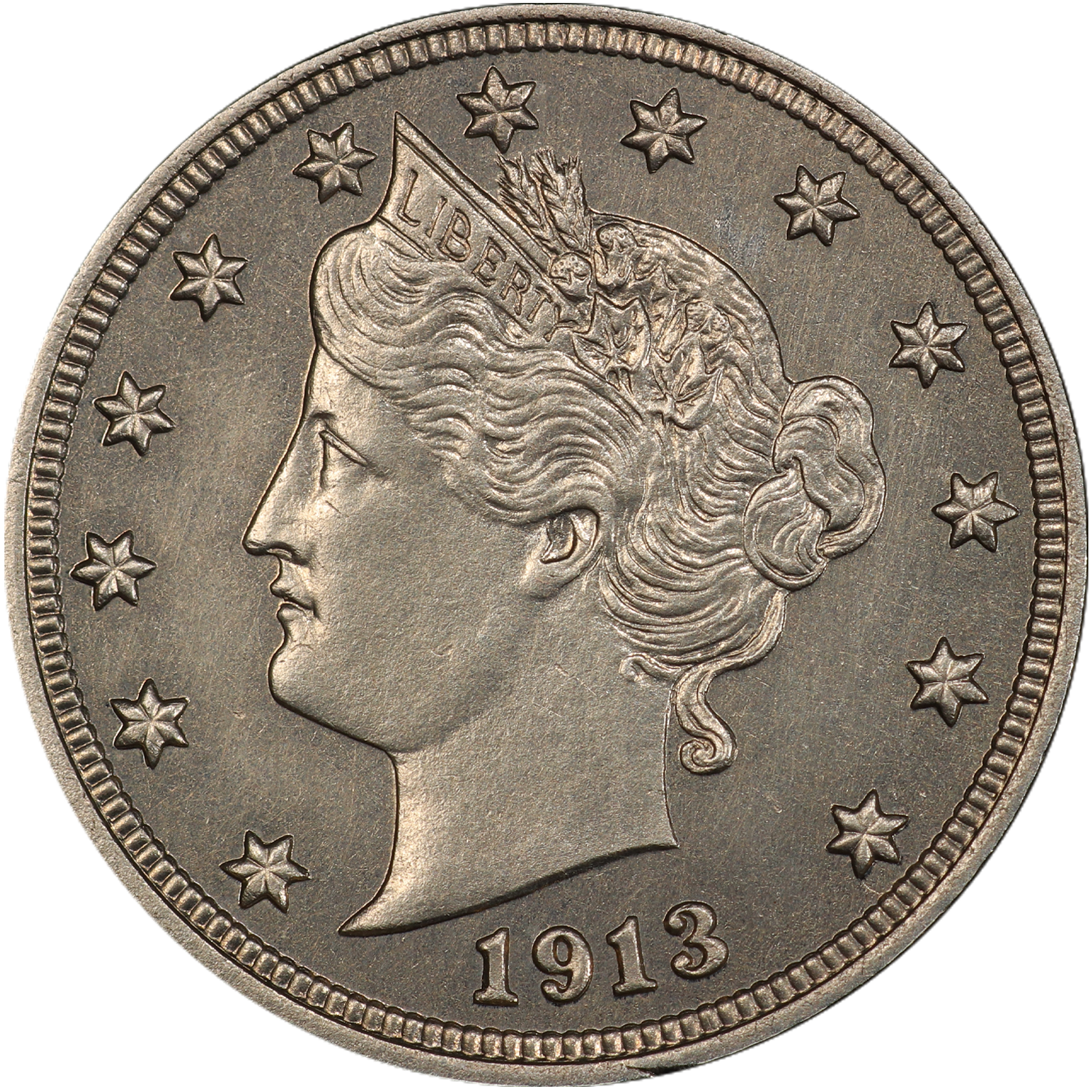 PCGS PR-66, CAC Sold for $4,560,000 View Lot 1096 | 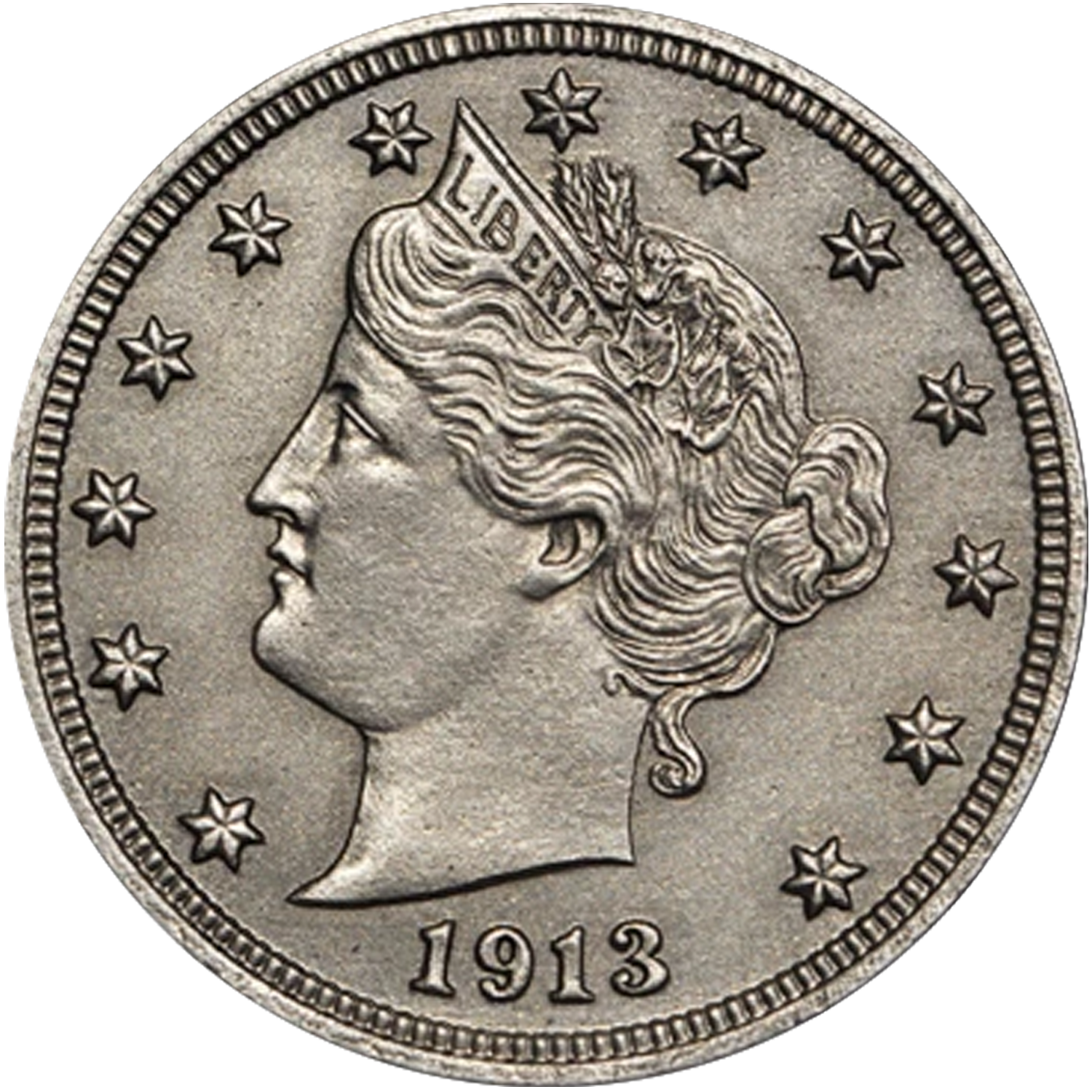 NGC PF-64+, CAC Sold for Over $4,000,000 View the Hawaii Five-O Nickel |
